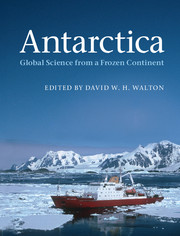Book contents
- Frontmatter
- Contents
- List of contributors
- Introduction
- 1 Discovering the unknown continent
- 2 A keystone in a changing world
- 3 Ice with everything
- 4 Climate of extremes
- 5 Stormy and icy seas
- 6 Life in a cold environment
- 7 Space science research from Antarctica
- 8 Living and working in the cold
- 9 Scientists together in the cold
- 10 Managing the frozen commons
- 11 Antarctica: a global change perspective
- Appendix A Visiting Antarctica
- Appendix B Further reading
- Acknowledgements
- Index
2 - A keystone in a changing world
Published online by Cambridge University Press: 05 March 2013
- Frontmatter
- Contents
- List of contributors
- Introduction
- 1 Discovering the unknown continent
- 2 A keystone in a changing world
- 3 Ice with everything
- 4 Climate of extremes
- 5 Stormy and icy seas
- 6 Life in a cold environment
- 7 Space science research from Antarctica
- 8 Living and working in the cold
- 9 Scientists together in the cold
- 10 Managing the frozen commons
- 11 Antarctica: a global change perspective
- Appendix A Visiting Antarctica
- Appendix B Further reading
- Acknowledgements
- Index
Summary
Ferrar had returned all right and had made a great find in the western mountains of fossil plants in some coal shale beds which means that the South Pole has at one time had an abundant vegetation.
Edward Wilson, 1902In contrast to today, Antarctica has not always been the cold, isolated continent sitting astride the South Pole. The mountains that protrude through the thick veneer of ice provide a past record that is very different to today, an intriguing glimpse of a continent that has preserved a remarkable record of how our Earth has changed through geological time, and how Antarctica amalgamated and combined with other continental fragments and drifted apart to form new ocean seaways. Despite Antarctica being almost completely covered in ice, with less than 0.5% of the continent exposed rock, we know a great deal about how the Antarctic continent has changed through time from the oldest rock, estimated by geologists to be about 3930 million years old, to the geological processes that are operating today. Our understanding has developed through the tireless efforts of early explorers who paved the way for modern day geologists visiting and sampling all accessible rock outcrops to unravel the mysteries of the hidden continent. Initially geologists travelled from rocky outcrop to rocky outcrop by sledge using reliable and trustworthy dog teams to be replaced in later years by mechanised motor toboggans and air support.
- Type
- Chapter
- Information
- AntarcticaGlobal Science from a Frozen Continent, pp. 35 - 66Publisher: Cambridge University PressPrint publication year: 2013
- 2
- Cited by



